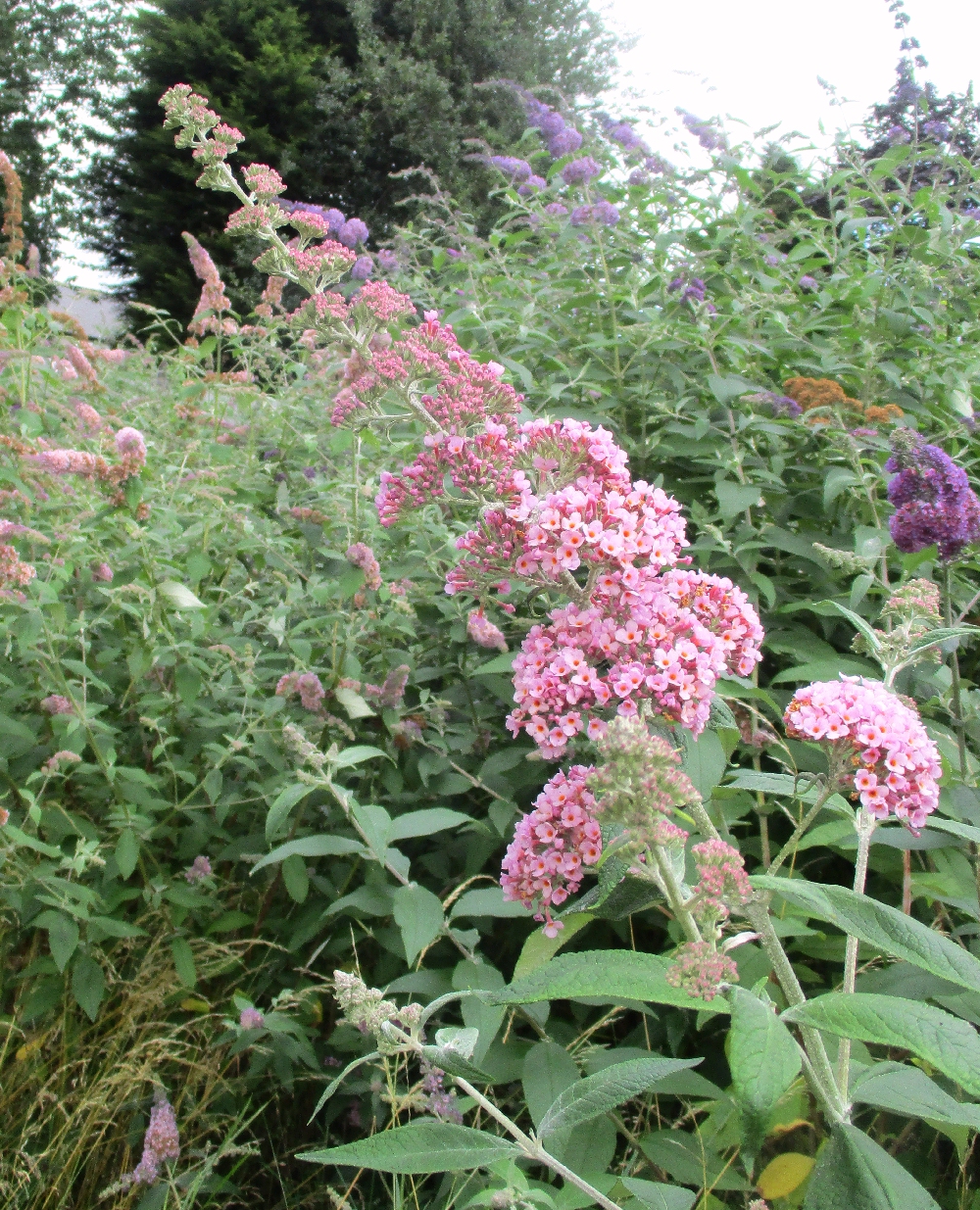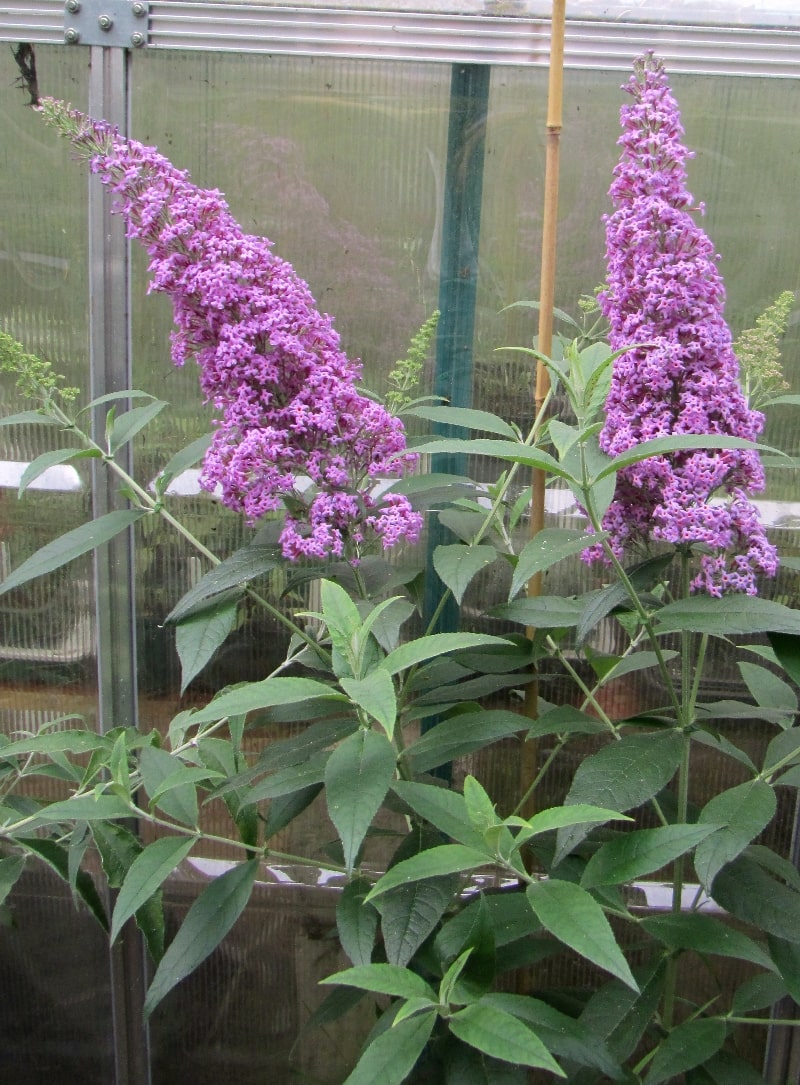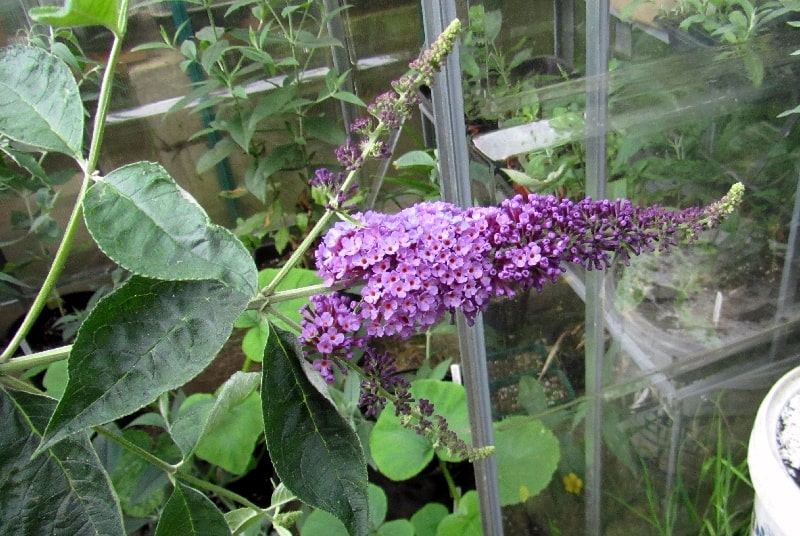
PODARAS BUDDLEJA HYBRIDS
Updated: July 2022
Peter Podaras in the USA has developed a large number of reportedly sterile or low-fertility hybrids in recent years: first at Cornell University (NY) with the FLUTTERBY® Buddleja marketed by Ball Ornamentals; then later at Hines Nurseries (CA) with 'Hinebud' cultivars, sold under several trade names. More recently, he has been working independently, and several more of his plants have joined the ranks. His cultivars are mostly hybrids of various species, often requiring several generations to achieve the end result. They are all patented in the USA and have Plant Breeders' Rights in Europe. Some have different trade-names according to location, so the official cultivar names (Podaras#, Hinebud# etc. as listed on the US Plant Patents) are also shown for clarity. The seed parent is shown first and the pollen parent second. However, I must introduce a caveat - the plant patent information is not necessarily reliable.
There are so many that they merit a separate page, although not all cultivars were available in Europe, and many have disappeared from the trade. I have been able to acquire and assess some of these plants and review their garden performance in the UK. Sadly, most have proven disappointing.
Most are fully hardy and many have been selected for a diminutive size, although the claims for low seed-set may be exaggerated at times. The smallest, lax cultivars are bred for container displays or hanging baskets, and are best treated like annuals as they will not survive year to year under normal garden conditions.
FLUTTERBY®
FLUTTERBY GRANDE®: large hybrids
The FLUTTERBY GRANDE® plants are not available in Europe. All are expected to grow to about 2 metres in height. SWEET MARMALADE and TANGERINE DREAM are unlikely to flourish in the UK climate given their progenitors. The other three are seedlings of B. x weyeriana, and I have been able to source a PEACH COBBLER for review.
FLUTTERBY GRANDE® VANILLA ('Podaras#1')
B. x weyeriana 'Honeycomb' x unnamed selection of B. davidii
A fairly typical white-flowered seedling of B. x weyeriana.
FLUTTERBY GRANDE® SWEET MARMALADE ('Podaras#2')
B. crispa x B. marrubiifolia.
Notable for its yellow-orange flowers, with similar panicles to B. crispa
FLUTTERBY GRANDE® TANGERINE DREAM ('Podaras#3')
B. marrubiifolia x B. alternifolia
Deep orange flowers.
FLUTTERBY GRANDE® BLUEBERRY COBBLER ('Podaras#4')
B. x weyeriana 'Honeycomb' x (B. marrubiifolia x (B. davidii x B. crispa))
Unusual exotic heritage, but looks much like other B. x weyeriana seedlings. Blue flowers which gradually fade to cream.
FLUTTERBY GRANDE® PEACH COBBLER ('Podaras#5')
B. x weyeriana 'Sungold' X B. x 'Pink Delight'
The one I've been able to grow, and it's basically the same as 'Pink Pagoda' (syn.: INSPIRED® PINK), although maybe a little less vigorous.

FLUTTERBY GRANDE® PEACH COBBLER has pink flowers without any 'peachy' shades.
FLUTTERBY®: medium-small hybrids
These were introduced in to Europe by Van Vliet and sold quite widely at first. Now they are difficult to source and are probably no longer generally available.
FLUTTERBY® PEACE ('Podaras#6')
B. davidii x B. alternifolia
This stayed very small, so was probably included in the wrong series. The inflorescence was few-flowered and ugly, and muddy mauve-purple in colour. The plants died after a couple of seasons.
FLUTTERBY® PINK ('Podaras#9')
Cross of unnamed selections of B. davidii
One of the few successes - large panicles of lilac-pink flowers, upright growth habit and it's still going after seven years. Grows to about 1.5 metres and is like a small 'Reve de Papillon Rose'.
FLUTTERBY® LAVENDER ('Podaras#11')
(B. davidii x B. alternifolia) x (B. davidii X B. alternifolia)
Rather uninspired colour to the flowers, much like a feral Buddleja, although the panicles are densely packed. The foliage is quite unusual - more rounded and somewhat glaucous. When I grew a couple of plants the height remained at just over a metre, but it proved short-lived both in a pot and in the ground.

FLUTTERBY® PINK is the best of the bunch.

FLUTTERBY® LAVENDER is a fairly routine colour.

FLUTTERBY® PEACE has very poor flowers.
FLUTTERBY FLOW®: spreading habit
FLUTTERBY FLOW® MAUVE PINK ('Podaras#7')
Cross of unnamed selections of B. davidii.
Unlikely to be just from B. davidii as described in the patent. The flowers are bizarre, with massively long corolla tubes and they are of a rather sickly pink hue. Small toothed foliage and a low habit. In the ground it succumbed to root-rot; the pot grown one continues to survive, although it's far from impressive. This one produces viable seed. This plant was mistakenly sold as FREE PETITE® DARK PINK by Suttons Seeds (UK) in 2013.
FLUTTERBY FLOW® LAVENDER ('Podaras#12') syn.: BUDDLEJA DAVIDII FREE PETITE® LAVENDER FLOW
(B. davidii x B. alternifolia) x B. davidii
Small, lax and survived about three months. Just long enough for it to produce a few insipid flower panicles.

FLUTTERBY FLOW® MAUVE PINK has peculiar long corolla tubes.
FLUTTERBY PETITE®: very small and compact
FLUTTERBY PETITE® BLUE HEAVEN ('Podaras#8') syn.: BUDDELJA DAVIDII FREE PETITE® BLUE HEAVEN
B. davidii x B. alternifolia (F2 resulting from self-pollination).
Excellent mid-blue flowers in long panicles. This small shrub is hardy, although not at all robust. The foliage is more ovate than lanceolate and dark green above. Of the two plants I had, the potted one has survived many years but remains a rather poor specimen. The one planted in the ground struggled and eventually succumbed to wind-rock. I have found it both fully seed- and pollen-fertile.

FLUTTERBY PETITE® BLUE HEAVEN has the best flowers in the series.

Several FLUTTERBY PETITE® cultivars were renamed BUDDLEJA DAVIDII FREE PETITE® for Europe.
FLUTTERBY PETITE® DARK PINK ('Podaras#10') syn.: BUDDLEJA DAVIDII FREE PETITE® DARK PINK
(B. davidii x B. alternifolia) x (B. davidii x B. alternifolia)
Run-of-the-mill flower colour, with small foliage reminiscent of the 'Nanhoensis' form of B. davidii. Mine stayed at 1 metre in height, but died due to a combination of wind-rock and root-rot. I've been reliably informed that if it were to establish, it might become quite a large plant after several years left unpruned.
FLUTTERBY PETITE® TUTTI FRUITTI ('Podaras#13') syn.: BUDDLEJA DAVIDII FREE PETITE® TUTTI FRUITTI
(B. davidii X B. alternifolia) X B. davidii
A good bright plum colour to the flowers initially, although they fade nastily to mauve. The plant is fairly weak and completely unsuited to planting anywhere but in a container or a very sheltered border.
FLUTTERBY PETITE® FUCHSIA ('Podaras#14')
(B. davidii x B. alternifolia) x B. davidii
Although listed, it's rarely been seen.
FLUTTERBY PETITE® SNOW WHITE ('Podaras#15') syn.: BUDDLEJA DAVIDII FREE PETITE® SNOW WHITE
(B. davidii x B. alternifolia) x B. davidii
Small foliage and it stays small, less than a metre in height and spread. The inflorescences are disappointing and it's shy to flower, never flowering until well into the autumn. On the plus side, it never produced seed capsules. My plant died after a couple of years from root-rot.
FLUTTERBY PETITE® PINK ('Podaras#16')
(B. davidii x B. alternifolia) X (B. davidii x B. alternifolia)
Shown in the catalogue, but doesn't appear to have had a wide release.
FLUTTERBY PETITE® BUBBLE PATH PINK ('Podaras#17')
Pedigree not availble and quite likely never released.

FLUTTERBY PETITE® SNOW WHITE
From the Ball Ornamentals Catalogue Circa 2013
'HINEBUD' HYBRIDS
'Hinebud1' syn.: Lavender Veil (US); Dreaming Lavender (UK)
The female parent is reported to be a complex hybrid of Buddleja davidii x B. alternifolia x B. caryopterifolia x B. lindleyana x B. crispa, and the male parent a hybrid of (B. davidii x B. alternifolia) x B. davidii. A low growing and lax plant intended for hanging baskets and containers. Planted outside in the soil, it soon rots off.
'Hinebud2' syn: Purple Splendour; Purple Splendor
The female parent is reported to be a complex hybrid of Buddleja davidii x B. alternifolia x B. caryopterifolia x B. lindleyana x B. crispa, and the male parent (B. davidii x B. alternifolia) x B. davidii ('Podaras #12'). An upright plant with large, upright panicles reaching approximately 1 metre in height. The flower colour is excellent. It's proven robust and hardy when others have fallen by the wayside.
'Hinebud3' syn.: Angel White (US); Dreaming White (UK)
Pedigree not availble. A small, lax cultivar more suited to containers. Mine died having failed to flower.
'Hinebud4' syn.: Dreaming Puple
Pedigree not availble. A small, lax cultivar more suited to containers. Essentially the same as 'Hinebud1', but the flowers are purple. It also failed to establish.
Dreaming Orange
An inter-generic hybrid of Gomphostigma virgatum and Buddleja marrubiifolia, it received only a limited release only in Europe. A small, lax cultivar with orange flowers and narrow, grey foliage, features intermediate between the two parents. Has proven hardy during mild winters if kept dry.

'Purple Splendour' is a robust plant, with large panicles of purple flowers.

'Dreaming Orange' is a unique hybrid of Gomphostigma virgatum.
RECENT INTRODUCTIONS
HIGH FIVE PURPLE syn: 'Podcept1'
Another small hybrid with a complex heritage, staying well under a metre in height and more suited to container growing, which has received wide release in both North America and Europe. The publicity suggests it has double flowers, although in my experience less than half the flowers on each panicle are actually doubled to any extent, and only a few substantially doubled. I've been told some UK nurseries have binned their production because of poor growth. My own plant is sickly, and the cutting I took is prone to both botrytis on the leaves and insect damage.
Summer of Love syn: 'Podarasnga2'
A compact (approx.1.5 metres height) Buddleja with pale blue flowers from Peter Podaras. It has received only a limited release by Springhill Nurseries, USA.
Blue Ribbon syn. 'Podarasnga3'
Fairly small (1.0-1.5 metres height) Buddleja, marketed by Springhill Nurseries, USA. Individual light blue flowers are larger than average and some are partially doubled.

HIGH FIVE PURPLE has pale mauve flowers and looks attractive in publicity photos (photo courtesy of crocus.co.uk).
POSTSCRIPT
My experience of these and the other new dwarf hybrids has not been positive for the most part - there are one or two exceptions. I could say it is my horticultural ineptitude and my poor growing conditions which have led to this negative view, although I have grown these hybrids alongside semi-tender or fussy plants like B. colvilei and B. crispa, which have thrived.
The publicity photos for the new dwarf hybrids look marvellous - healthy plants smothered in huge colourful flower panicles. Well, that's possible if, like the commercial nurseries, you douse the plants regularly in growth stimulants, fungicide and other pesticides. And keep them under cover at ideal temperatures and light levels in a monitored growing medium. But these are Buddleja, not exotic orchids, and they should be able to withstand at least some buffeting from the elements and have reasonable disease resistance.
Often the claims for sterility and great flowering performance have proven false. Problems with production and growth means many have already disappeared from the catalogues and been withdrawn from sale. Novelty seems to be the name of the game - don't worry about whether the plant is any good, just make sure something new is in the catalogues. It's a competitive market, and companies want their own exclusive range, even if these 'me too' plants are of little or no horticultural merit. So, the flow of new hybrids will probably continue. The majority of the names now in the catalogues will be forgotten and those plants will become extinct.
I understand that not everyone has a large garden, or even a garden, yet they'd still like to grow a Buddleja. The advice for small gardens is not to have multiples of small plants, but to have a single large feature plant. For containers, the better dwarf hybrids may well suit; however, this is comes with the caveat they will need regular replacing with new plants from the garden centre, an increasing expensive practice.
And finally there is the ascetic consideration. Often they just don't look 'right'. I'm sure a great level of skill and effort, not to mention investment, has gone into their development. Endeavouring to shrink what is naturally a vigorous shrub has also bred in many of the failings, like short life-spans and reduced disease resistance, and the resulting plants can often be ugly.
Email:
buddlejagarden@gmail.com
© The Buddleja Garden 2011-2025.



